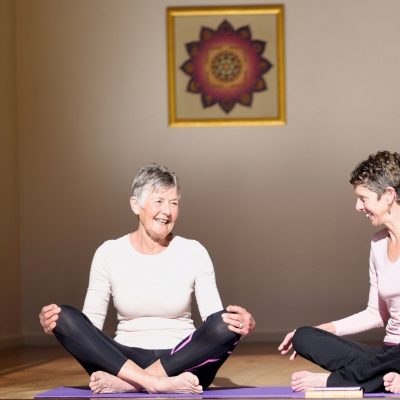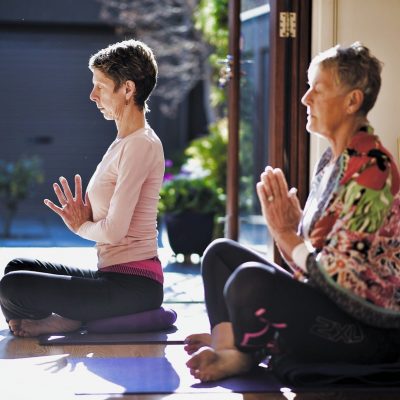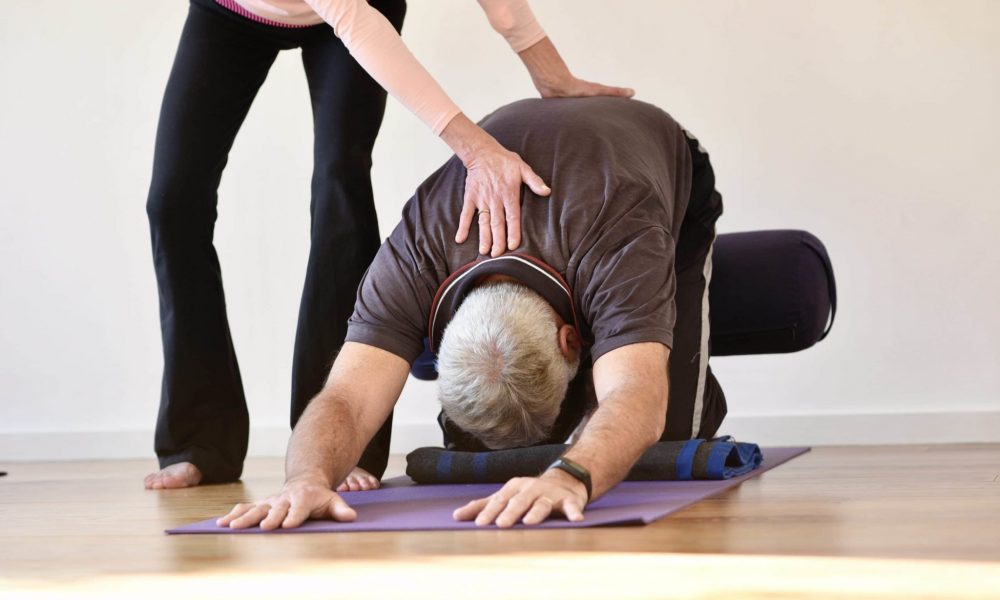I am a 66-year-old male, recovering from a motorcycle accident. I drive race cars for a hobby, work long hours in my own business and have never been stiffer. Not in my wildest dreams could I imagine the difference in movement in my body and more importantly the relaxation mood that yoga puts me in. I am so grateful and am a complete convert. Joe
Last Christmas, Joe’s family gifted him with Private Yoga Therapy sessions. He started weekly in January and despite Covid lockdowns has continued here regularly. He now comes twice weekly as he admits that home practice is not for him! Joe has learnt firsthand how the restorative poses calm down his nervous system and then: reduce his body tightness, aches and pains; lower his blood pressure and help him get less angry. Essential for his long-term health and happiness!
This is what the everyday person like you and Joe, gain from restorative yoga (restful, supportive poses).
A guided way to slow down and rest
Perspective, relaxation, self-care can never arise from busyness, especially from a busy mind. Particularly if your life has become a pit-stop, something you rush in and out from trying to find a ‘fix’, a solution. For most people, slowing down, disengaging from social media, turning off devices, pausing, creates a lot of inner discomfort. To stop and realise how and to what/whom you give your energy and time is confronting, but incredibly healthy.
A calmer mood and mind
When you don’t rest, you wear out, wear down, and start running on empty. You spend so much of your time trying to get somewhere. It’s healthy to pursue wholesome aims, however your bodily systems and brain get overloaded and stressed. Restorative (or restful) poses condition the body to ease up and then the mind begins to let go. You gain calm, clarity and focus again, without effort. Your natural energy is released, your mood naturally lifts and your thoughts are more conducive to an easeful life.
A strengthened immune system
Restful, supportive poses create an enhanced capacity for healing and healthy immune functioning. Your immune system requires strengthening to inhibit illness. A superfine essence called Ojas has everything to do with your immunity and gives all of your bodily tissues strength, vigor, vitality, and immunity. It is said that rest enhances the strength of your Ojas and reduces the external influences that cause disease in you e.g. Covid.
A personal place of balance
Creating a personal sense of balance, finding equilibrium within, is paramount. There are many paths to your centre. Silent meditation practice is one of them, however many find this unachievable. Restorative yoga brings your being into this inner balance bringing clarity, resilience, patience, acceptance of what is. Your heart/mind recentres to observe daily life with an open heart and kindness.
Learn and encourage your body, breath, emotions and mind to rest, replenish and rebuild through restorative yoga.
How Restorative Yoga supports your nervous system
The seed of every new habit is a simple, tiny decision. When we stumble across a new practice that we find especially beneficial, we need to create a new groove in the brain to reinforce new actions and reactions. This only happens with practice and regularity too! Developing a new habit is best approached with one small step at a time and a new habit that can change our health is a great motivator.
What happens when your nervous system is overactive?
- secretion of the catecholamines (hormones) adrenaline (epinephrine) or noradrenaline (norepinephrine), resulting in immediate over activity of all your physical bodily functions.
- the release of chemical messengers that produce the hormone cortisol, which increases your blood pressure, blood sugar, and suppresses the immune system.
- subsequent reactions to boost energy, that trigger the binding of adrenaline to your liver cells and the subsequent increased production of glucose, precipitating chronic health conditions.
- an increased intensity of your emotional responses - individuals with higher levels of emotional reactivity may become more prone to anxiety and aggression.
How your body changes from this over-activity:
- uncomfortable physical changes like muscle tension, headache, upset stomach, racing heartbeat, and shallow breathing.
- a range of physiological changes including increased metabolism, blood pressure, heart and breathing rate, dilation of pupils, constriction of your blood vessels.
- numerous stress-related medical conditions including cardiovascular disease, gastrointestinal diseases, adrenal fatigue.
‘Manipulating’ your nervous system
Restorative yoga consciously ‘manipulates’ your nervous system with the intent of:
- stimulating the calm state (parasympathetic) of your nervous system to promote healing and recovery, and counteracts the physiological effects of stress from the ‘fight or flight’ response.
- enhancing your personal ability to encourage your body to release chemicals and brain signals that make your muscles and organs slow down and increase blood flow to the brain.
- triggering the ‘relaxation response’ to help any health problem that is caused or exacerbated by chronic stress such as fibromyalgia, gastrointestinal ailments, insomnia, hypertension, anxiety disorders and so many more.
Restoring inner balance – restorative poses
- their main function is to activate the ‘rest and digest’ response and return the body to inner balance, homeostasis.
- open (dilate) blood vessels leading to the gastro-intestinal tract, aiding digestion; stimulate salivary gland secretion and accelerate peristalsis, help the absorption of nutrients to enhance nutrition; engorge the male and female genitals to stimulate hormone production; constrict the bronchioles of the lungs to conserve energy.
- engage and activate the release of the neurotransmitter acetylcholine – these levels rise when we are sleeping, helping to slow the heart and simulate calm.
- conserve energy in your body and are responsible for ongoing, mellow, steady-state activity. The feeling is of relaxation, often with a sense of contentment.
Teaching Yoga Teachers the art of Restorative Yoga
Introducing restorative classes into my Studio Timetable over seven years ago now, seemed a ‘misguided’ step. ‘Yoga’ had just exploded everywhere as an ‘exercise’ class. It was included in gym memberships and was all about fancy poses. However even before my initial restorative class at the Studio, these sessions were continuously booked out with a waiting list. What amazed me was that people were literally paying me to relearn how to ‘rest’.
This is what a Titled Sports and Exercise Physiotherapist, who works with the Australian Olympic Gymnastics team, has to say about these classes:
Caroline’s restorative yoga classes are a wonderful experience and such a beneficial addition to a busy week! Caroline’s calm, professional and knowledgeable teaching make for a fantastic class. Her attention to detail and knowledge of anatomy and biomechanics mean the classes are suitable for all levels of yoga experience and even those with pathology. Kate, Senior Physiotherapist, owner @BodyLab
Now many years later, these therapeutic skills differentiate my Studio and Privates. Refining these practices in my Yoga Therapy work alongside numerous clients living with a range of chronic health conditions, gives me an experiential ‘edge’ in my field.
As a Yoga Therapist, I’m continuously working with people who are feeling fatigued, stressed from daily activities, or have been advised for their health that they need to slow down. Restorative practices offer a wonderfully versatile approach suitable for almost anyone.
Listen to what Frances, a registered Level 1 Yoga Teacher, has learnt by accessing my online Course, Learn to Rest:
This Course was so helpful to build on my resources for teaching (and practising) restorative yoga. Caroline shares her deep knowledge in such an accessible way, combining written resources with video and audio clips to cater to different learning styles and reinforce the lessons. Being able to repeat the practices myself helped me to absorb the knowledge in order to share them with greater confidence and clarity. It has also helped me to adapt more easily to the different needs of clients in both private and group settings.
If you are a Yoga Teacher, learning and teaching even the foundational restorative practices can assist people to:
- move their nervous system into a relaxed state.
- help them experience less pain and discomfort.
- bring their body and breath simultaneously into an easeful state.
- assist them to have more restful sleep.
- enhance their energy and vitality, as their natural energy is released.
Our number one job as a teacher is to find our inner radiance and inherent goodness so that we can mirror this for others. You cannot be compassionate if you are exhausted. Do what you need to do to be rested and relaxed. Then you can access that inner container in which your inherent goodness and compassion can shine.
To learn more for yourself and others, explore my Online Course, Learn to Rest.












